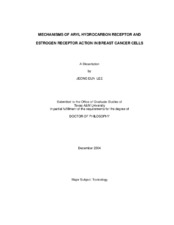| dc.description.abstract | In MCF7 and T47D cells cotreated with 1 nM 2,3,7,8-tetrachlorodibenzo-p-dioxin (TCDD) plus 0.1-10 μM 3Â’,4Â’-dimethoxy flavone (DMF), there was a concentration-dependent decrease in the TCDD-induced ethoxyresorufin O-deethylase (EROD) activity. Gel mobility shift assays showed that 3Â’,4Â’-DMF inhibited TCDD-induced aryl hydrocarbon receptor (AhR) transformation in rat liver cytosol and blocked TCDD-induced formation of the nuclear AhR complex in MCF7 and T47D cells. The antiestrogenic activity of TCDD in estrogen-induced transactivation assays in MCF7 cells was reversed by 3Â’,4Â’-DMF, confirming the AhR antagonist activity of this compound in breast cancer cells.
Cotreatment of T47D and MCF7 cells with TCDD and 10 μM resveratrol inhibited induction of CYP1A1 mRNA and EROD activity. Resveratrol did not inhibit TCDD-induced AhR transformation and reporter gene activity. Actinomycin D chase experiments in T47D cells showed that the mechanism of inhibition of CYP1A1 mRNA and EROD activity is due to an increased rate of CYP1A1 mRNA degradation, suggesting that resveratrol inhibits CYP1A1 via an AhR-independent post-transcriptional pathway.
Vitamin D receptor-interacting protein 150 (DRIP150) coactivated estrogen receptor α (ER α)-mediated transactivation and the response was AF2-dependent in ZR75 breast cancer cells. C-and N-terminal NR-boxes (amino acids 1186-1182 and 73-69, respectively) were not necessary for coactivation of ERα. Analysis of DRIP150 deletion mutants identified a 23 amino acid sequence (811-789) required for coactivation. The 23 amino acid contained two regions at amino acids 789-794 and 795-804 which resembled α-helical motifs identified in Lanuguinosa lipase/histamine N-methyl transferase and hepatocyte nuclear factor 1, respectively. A squelching assay using specific point mutations within each α-helix showed that the NIFSEVRVYN (795-804) region was the critical sequence required for the coactivator activity of DRIP150. | en |


